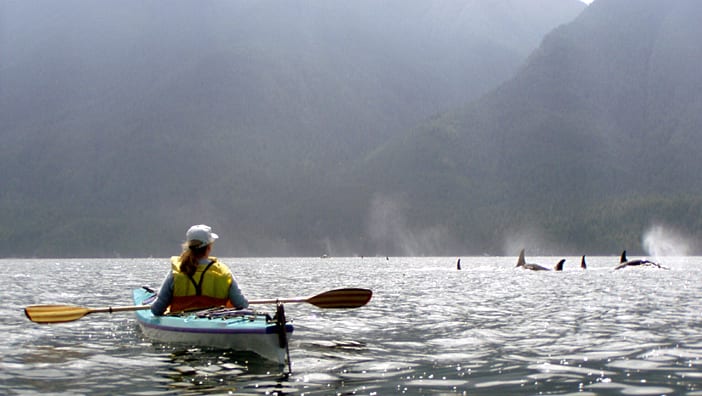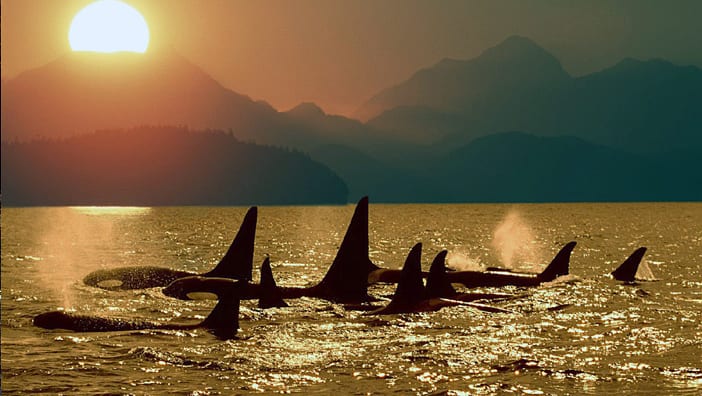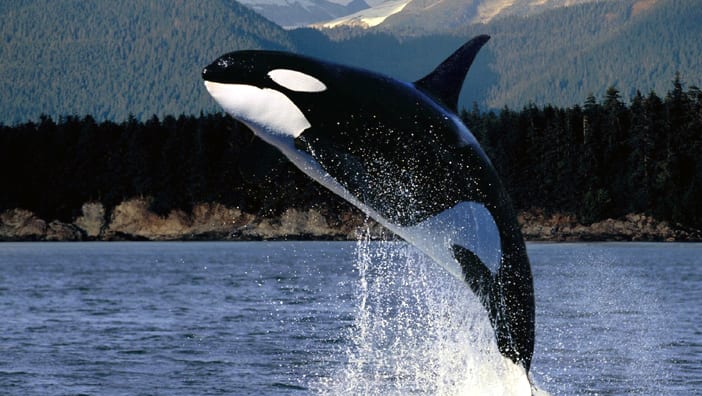Kayaking with Orca Whales Itinerary
Sea Kayaking: Our kayaking with Orca Whales Adventure Trips in Johnstone Strait in British Columbia, Canada allows the paddler to slip silently across the waters, explore shallow inlets and coves, and approach marine mammals and birdlife without disturbing their calm. Previous experience is not necessary. Our expert guides will provide instruction in technique and safety. We use double and single sea kayaks for our expeditions. You can expect to paddle for approximately 4 hours per day.
Due to the unpredictability of weather, participants must be willing to expect the unexpected. As we are moving camp each day, there may be the need to paddle for longer than intended periods to accommodate winds or rough water. Unsafe water conditions may necessitate sitting onshore until conditions for safe travel present themselves.
 |
 |
 |
Johnstone Strait off Vancouver Island is the ideal location to go kayaking with Orca Whales and observe and photograph one of nature’s truly magnificent mammals. The sleek, beautiful ebony and ivory Orcas congregate in Johnstone Strait during the summer to feed, socialize and rub themselves on pebble beaches.
A complete itinerary along with maps, clothing and equipment list, will be issued upon registration.
Day 0: Arrival in Nanaimo
This denotes the day(s) spent in Nanaimo before the listed start date of the trip.
- Day 1 Pick up and travel to our put-in location in Alder Bay.
- Day 2-5 Paddling Journey
- Day 6 Return to Nanaimo
inclusions and exclusions at a glance
What’s included in this tour (Items that are covered in the cost of tour price).
- Transportation from Nanaimo, and return
- Sea kayaks and gear (pfd, paddle, spray skirt, etc.)
- Dry bags for your clothing and sensitive gear
- Snacks/beverages on the expedition
- All meals while on the kayaking portion**
- Meal preparation
- Camping and use fees
- Exceptional guides for the entire journey
- Cooking gear/camp stoves/water filtration
- Tents & tarps
- Emergency radio/satellite phone/major first aid supplies
- † We can provide sleeping bags, sleeping pads, and booties for rent
Whats not included in this tour (Items that are NOT covered in the cost of tour price).
- Transportation to point of origin, transfers, personal equipment, accommodation and food other than included in the itinerary.
- Gratuities are not included. Our guides make every effort to ensure your holiday is all you expected and more. Recognition of a job well done is always appreciated; $10-20/day per guide is recommended.
- Single tents †(available for a single supplement charge)
Meals: provided are indicated in the itinerary as: B- Breakfast, L- Lunch, D- Dinner
| You will have entered into a group dynamic. Decisions taken by our leaders are directed to the welfare of the group. Although they will strive to meet individual needs, it may not always be possible under given circumstances. |
Johnstone Strait:
Near the northern tip of Vancouver Island, it is witness to one of nature’s most fascinating annual occurrences. Pods of Orcas or Killer Whales congregate here from mid-July to late September. Their visit coincides with the return of the salmon on their way to spawn up various inland waterways. The orcas take advantage of the salmon’s return to feed and socialize with other pods.
We will do our best to locate Orca pods. The route we follow, and the area we kayak, does present the best opportunity to view Orcas. However, they are wild animals and Johnstone Strait encompasses a huge area, so we cannot guarantee sightings. It is also important to note, that should we encounter Orcas, we, by conscience and by agreement with private and governmental stewards, respect a 100-meter off-limits zone.
As kayaking goes, there is little to compare with the thrill of paddling alongside these awesome, exhilarating, and magnificent mammals. Coupled with this, is the myriad of small bays, sandy beaches, protected coves, lush rainforest, and marine wildlife that is characteristic of these waters.
Orcas:
The Romans called them Orcas, literally “demons from hell”. Spanish whalers called them “whale killers” after their vicious and coordinated attacks on other whales, and now they are called killer whales or simply Orcas. Having received some pretty bad press over the years, their image has improved recently as a result of research which has shown that they are intelligent, social creatures, and harmless to humans.
Orcas are the largest members of the dolphin family and are second only to humans as the most widely distributed mammal on earth. They are characterized by their large size (males can reach 9.5 m and weigh 10 tonnes), distinctive black and white markings, and prominent dorsal fin that can reach up to 1.8 m in length. --Read More--
There are, in fact, three distinctly different types; residents, transients, and offshores. Residents are the most studied because they do not stray very far from their home territory during summer, and they return year after year to the same area. Transients roam over a larger coastal area than the residents and travel in smaller groups, sometimes hunting and traveling as a pair. Very little is known about offshores at this time. They are known to travel in large groups of up to 60 individuals, and they seldom venture into protected waters.
In the early 1970s, it was discovered that it was possible to identify Orcas by unique markings on their dorsal fins and the appearance of a “saddle” patch at the base of the fin. This led to photo identification and the ability of researchers to monitor orca populations, track their movements, and study their social behavior. Pods can also be identified by their vocalizations.
The majority of Orcas in Johnstone Strait are residents, but transients are seen at times. The major difference between the two subspecies is diet. Residents have adapted to a diet of fish, mostly salmon. Transients appear to feed exclusively on seals, sea lions, and porpoises. They have been even known to enjoy the occasional deer and moose, as these will swim narrow coastal channels.
These feeding patterns explain the high resident population in Johnstone Strait. Between June and September, thousands of salmon pass through the confined strait on the way to their spawning grounds. They feast on the salmon and then return to open water during winter and spring.
Thanks to the identification procedures much is known about the social structure of maternal groups, sub-pods, clans, and communities. These terms are used to describe groups of Orcas that range in size from 4 (maternal group) to up to 300 (a community). Pods typically contain 20 Orcas but as many as 50 have been observed.
Orcas are unique in that family units stay together and do not disperse. A maternal group may contain four generations whose ages could well parallel a human family. Females may reach the age of 80, and usually give birth around 15. Orcas belong to a matrilineal genealogy, that is, an individual’s ancestry is traced through it’s mother and her relatives. To avoid inbreeding it is thought that males mate with cows in other pods, so paternity is usually not known.
Orcas identify each other and other groups by vocalization called dialects. These high-pitched squeals, squawks, and screams (not to be confused with the “clicking”
sounds that are used for echolocation) form their “language”. To the trained ear, it can be used to identify pods. Dialect also distinguishes resident, transient, and offshore Orcas. The vocalizations appear to be used as a communication device to stay in touch with family members or to identify other Orcas pods. Different families do not appear to communicate vocally because they have different dialects.
On the whole, the number of Orcas in Johnstone Strait is increasing at a 2.5% rate per year to a believed healthy total of 200. Orcas are competing with sport
and commercial fishing which ultimately determines whether they continue to remain in the area during summer or go elsewhere.
Kayaking With Orcas Accommodation Options
GETTING THERE
If you are traveling into the Vancouver, Victoria, or Nanaimo area from afar, you should arrive at the departure location (in Nanaimo) for your trip the day/evening prior to the trip start date and plan to leave the day following trip return.
You can fly to Vancouver (airport code YVR) or Seattle (airport code SEA) then connect to Vancouver Island using ferry, bus, or air, or arrange flights directly to Vancouver Island.
Flying to Victoria (Airport code YYJ)
Flying to Nanaimo (Airport code YCD)
Nanaimo Airporter shuttle service. Servicing all of Vancouver Island from airports to ferries to cruise ship terminals. Tel: 1 250 758-2133
BC Ferries 1-888-BC FERRY (1-888-223-3779) We will let you know the ferry to take for traveling to Vancouver Island, but if you want to check out times, you can go the BC Ferries website at: www.bcferries.com/schedules/
WHERE TO STAY
Naniamo Pick up & Hotels
Pick up: Departure Bay, Duke Point Ferry Terminal, or the following Accommodations:
Days Inn Harbour View Nanaimo
Address: 809 Island Hwy South, Nanaimo, British Columbia, Canada, V9R 5K1
Phone (250) 754-8171
Website: www.nanaimohotel.com
Best Western Dorchester Hotel
Address: 70 Church, Nanaimo, British Columbia, Canada, V9R 5H4
Phone: (250) 754-6835
Website: www.dorchesternanaimo.com
Painted Turtle Guesthouse
Address: 121 Bastion Street, Nanaimo, British Columbia CANADA, V9R 3A2
Toll Free: 1-866-309-4432
Phone: (250) 753-4432
Further Reading
❖ Cole, Douglas and Chaikin, Ira. An Iron hand Upon the People. Douglas & McIntyre, 1990.
❖ Ford, John, Killer Whales*. U.B.C. Press, 1994.* Definitive work on Vancouver Island’s orcas
❖ Halliday, W.M. Kwakiutl: Potlatch and Totem. J.M. Dent, 1935.
❖ Kreitman, Richard. Whale Watching on the Pacific Coast. Harper Collins, 1995.
❖ Woodcock, George. Peoples of the Coast. Hurtig Publishers, 1977.
Prices do not include the 5% GST sales tax.
Booking: The booking requires a 30% deposit by Visa or Master Card with the balance due 60 days prior to trip departure.
The trip dates do sell out so please book early to get the trip dates you want.
